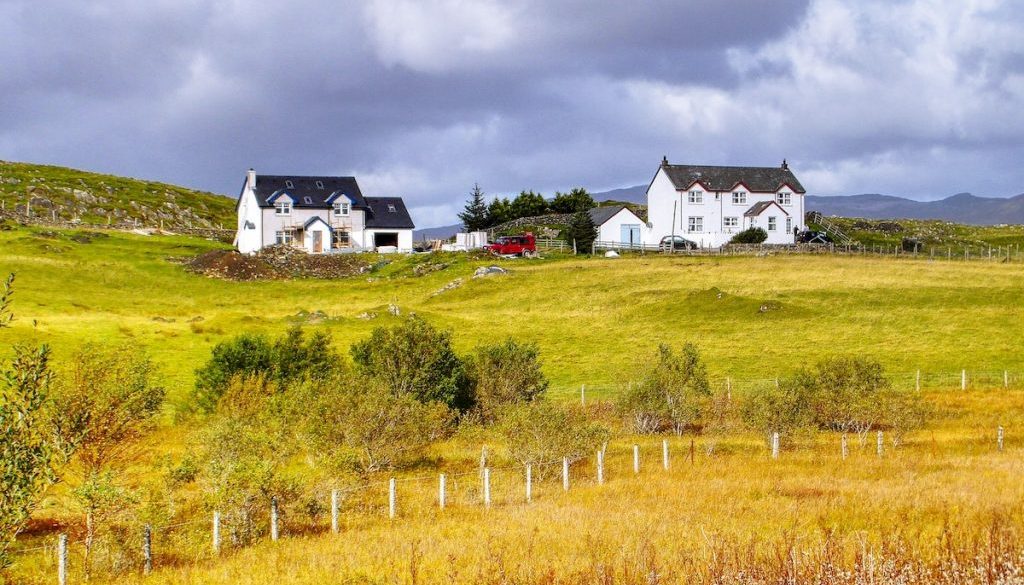Are more people looking to escape to the countryside?
Living through lockdown has left many of us rethinking our homes, and where we live, in ways we may never have imagined. When your entire life takes place within the confine of the walls of your home, how much space you have and what that space looks like takes on new meaning. During lockdown some people have missed their home – or rather coming home – as it’s been turned into a workplace or school rather than a place of calm and relaxation. As we look to a new normal how will we incorporate our new habits, hobbies, working patterns and lifestyles into our homes? For some, COVID has triggered a reappraisal of city dwelling. How will our experiences of lockdown influence future living – and what might this mean for rural places? Jessica Sellick investigates.
………………………………………………………………………………………………..
The Office for National Statistics (ONS) is compiling data on the social impacts of COVID-19. This adapts the Opinions and Lifestyle Survey (OPN) from a monthly omnibus survey to a weekly survey to collect data on the impact of the pandemic on day-to-day life in Great Britain. During the period 18-21 June 2020 2,500 individuals were sampled, with a response rate of 1,920 (or 77%). The results were then weighted to provide a nationally representative sample for Great Britain. The analysis shows that 28% of adults are planning changes to their relationship, job or home after we have recovered from COVID-19. Of these, 42% want to make a change to their work, 38% a change to a relationship; and 35% to move home. The analysis further reveals how 4 in 10 adults feel some parts of their lives have changed for the better since the pandemic – and of those reporting positive lifestyle changes 56% said they were able to spend more quality time with their loved ones with whom they share a home. Of these, 86% said they wanted this to continue after the pandemic. What do these findings mean for rural places? I offer four points.
Firstly, we know more people have been searching for, and looking at, rural properties online. Research by Rightmove compared people phoning or emailing estate agents about homes for sale during two weeks in mid-June with the first two-weeks in March before lockdown, finding agents experienced a 32% increase in enquiries, with people typically wanting family homes of three or four bedrooms and being prepared to pay 98% of the asking price. With Hereford seeing a 77% increase in online searches, Steven Thomas from Watkins Thomas, described how “our market [in Hereford] has been very busy since we were able to reopen in May. There’s been a shift in the type of buyer since before lockdown. We were dealing with a lot of first-time buyers with limited deposits in March, but now it’s families looking for more space. It’s a bit like what we see in January – families spend Christmas sitting down and talking about their next move and they get going in January. We’re now seeing people, having sat down during lockdown and reviewed what they’re looking for, jumping into action in June.” A survey of buyers and sellers registered with Savills in May 2020 found 51% of people in London were considering a move outside the city [compared to 42% for the same period of 2019] and 30% were more likely to consider a village or countryside location for their next move. Half of the respondents said having a garden or outdoor space had become more important to them – and if compromises were needed they would forgo another bedroom for an outside area.
Financially, some people are starting to view countryside properties as offering better or good value-for-money compared to flats and houses in city locations. According to Savills the average property bought by a first time buyer in London costs approximately £446,815 and requires a deposit of £142,464 against an average salary of £83,245. Compare this to the North East where average house prices are amongst the lowest in the country at £157,291 and the average salary £30,660. For many first time buyers the data highlights how without high earnings, help from parents/friends for a deposit and/or combining savings with a partner many people find it difficult to get on the property ladder.
To lift some of these barriers and unlock the housing market, between 8 July 2020 and 31 March 2021 the Government has introduced a stamp duty holiday in England and Northern Ireland. This means the threshold at which you need to pay tax has increased from £125,000 to £500,000. Analysis by Savills shows if you were buying the average home in England, worth £248,000, you would pay no stamp duty at all saving £2,460; and if you were buying a £500,000 property you would save the maximum of £15,000. Regional data suggests this will lift an additional 86% of home movers in the South West out of stamp duty; in the East of England the proportion of tax free sales is expected to rise from 4% to 87%, in the North East the rise will be from 41% to 98% and in London the rise will be 55% [NB: the percentage rise is lower for London because property sales will remain above the new threshold]. However, while it has been suggested this policy intervention will help those who want to upsize, buy a second home, or a property to let i.e., the people viewing countryside properties online; there is a recognition that access to mortgage finance remains a significant barrier, particularly for first time buyers. Indeed some economists expect consumer confidence to plunge from October when the furlough scheme ends and amid uncertainty of a transition deal or no-Brexit in December.
Interestingly, the urban property market has already started to respond. Data from Hamptons International and Countrywide reveals how landlords in London reduced current tenants’ rents in March-April and have dropped prices for newly let properties since then. Renters in London, for example, saw the biggest drop in rent, down 2.2% year-on-year to an average of £1,656 a month; with rent on a 3-bedroom apartment on Marylebone Lane in London, for example, falling from £3,250 per month pre-COVID to £2,600 now. This is being driven by an increase in the stock of rental properties and declining demand (e.g. international students have left, corporate lets have been cancelled, people are finding themselves unemployed, and non-UK visitors are staying away). In comparison, homes for rent in the suburbs have increased in their rental value. Figures from the OME show the initial cost of renting is down by 2% (£90 across England) – however it is up in some places, including in the Vale of the White Horse (by 11%). Taken as a collective, this data reveals increasing interest in rural living and some evidence of falling property prices in urban locations.
Secondly, more people are working differently and thinking about how and where they work. According to ONS, in March 2019 just 5% of us worked mainly from home. Pinterest found searches on ‘how to create a home office’ increased by 424% in May 2020. Now the lockdown has shown for many people that working from home is possible. According to Working Families, during lockdown 85% of parents worked flexibly, a shift from before COVID-19 when one-third of parents were not given the option to do so. Twenty-six major employers [including companies such as TSB, British Gas, Centrica, Zurich and Network Rail] have called for improvements to flexible working. In practice, this may lead people to live further away from the office and outside of expensive postcodes. A survey for the Business Clean Air Taskforce found nine out of ten respondents to a survey who had worked at home during the lockdown would in part like to continue to do so. Respondents described “reductions in stress, avoiding rush hour commuting, and more time with loved ones.” Yet in recent weeks the Prime Minister has been urging people working from home to go back to work if they can – and wants us all to start using shops and restaurants again. Will this lead to more people wanting to move to the countryside and spend one or two days a week commuting into the office?
If COVID-19 has led people to reassess and reduce the frequency and time they spend commuting, will this lead more people to want to work from home? If so, what are the implications for connectivity (broadband, mobile), work spaces and remote working in rural areas?
Thirdly, will we see greener and more energy efficient homes in the countryside? With the Government seeking to secure a “green recovery”, it intends to launch a £2 billion Green Homes Grant Scheme in September 2020 where vouchers [up to a maximum of £5,000] will be awarded to home owners in England to make energy efficiency improvements such as installing loft, floor and/or wall insulation or double-glazing. Research by MoneySuperMarket has found 51% of households are planning to apply to the scheme when it opens, with a further 26% considering doing so. According to data analysed by the BBC in March 2020, two-thirds of UK homes failed to meet long-term energy efficiency targets; with some 12 million homes falling below Grade C on Energy Performance Certificates (EPC) graded from A-G where A is the most efficient and G is the least efficient. Similarly, the Energy Saving Trust found one-third of 19.4 million homes with cavity walls to lack insulation, with one-third of the stock with less than 150mm of loft insulation. In practice this means householders have to spend more on their energy bills and leads to higher CO2 emissions. The Government had set a target of upgrading as many homes as possible to Grade C by 2035 and for fuel poor households and rented homes to reach the same standard by 2030. The analysis of average CO2 emissions per property per year by Local Authority District shows an urban rural split: with the highest emissions in Eden (7.39 tonnes), followed by Ceredigion (6.29 tonnes), Ryedale (6.53 tonnes), Powys (6.29 tonnes), Gwynedd (6.22 tonnes), West Somerset (6.17 tonnes), Richmondshire (6.14 tonnes), Carmarthenshire (6.13 tonnes), West Devon (6.04 tonnes) and the Derbyshire Dales (5.85 tonnes). This tends to be because homes in rural areas are not all connected to the gas grid, use fuels like LPG or solid fuels and are older stock compared to urban areas. Will the Government’s new scheme identify and support rural fuel poor households and ‘hard to treat’ rural properties? Is an area-based, rural-only approach, required within the scheme?
Fourthly, will we see more homes being built in the countryside? The Government has established project speed to deliver public investment projects more strategically and efficiently. The Government is due to release a policy paper shortly, setting out proposals for reforming the planning system in England. The paper will sit alongside existing measures such as a £12 billion affordable homes programme to build up to 180,000 homes (for ownership and rent) over the next eight years. Project speed is considering proposals for developments of 1,000 homes or more to require fewer consents; reducing the public consultation period from 6 months to 4 months. The last session of the Parliamentary Inquiry into Rural Health and Care explored housing in rural areas. Evidence from the Rural Housing Alliance (RHA), Shelter, Cornwall Rural Housing Association (CRHA) and the National Community Land Trust (CLT) Network covered issues around demography (rural areas having an ageing demographic), connectivity (broadband), adaptability (future proofing homes so people can get in, out and around their homes) and the desirability versus reality of living in the countryside. The session highlighted the implications of COVID-19 and the role housing plays in preventing admittance to hospital or supporting discharge [requiring step up and step down homes in rural areas], affordability [and how living in an affordable home provides a buffer against income shocks such as the economic impact of COVID-19], and the need for a wider housing offer in rural areas [different tenures and types including affordable, supported, shared ownership and social rent]. How much new housing does rural England need and how can we ensure the investment and commitment is there so we build the right homes in the right places?
Pre COVID-19 many people thought they would love nothing more than being able to spend all of their time in their homes with loved ones. Now some are realising that to fully appreciate their family they either need to leave them (preferably for 8 hours a day!), remodel or look for somewhere else (bigger, with outdoor space) to live. During COVID-19 the countryside has been seen as a haven and people have loosened their focus on cities. Will this interest in rural living stick as we emerge from lockdown? Watch this space.
…………………………………………………………………………………………………
Rural words will now be appearing bimonthly on the RSN website, with the next issue due in September. In the meantime, all of the updates are available on the Rural Words website: http://ruralwords.co.uk/
…………………………………………………………………………………………………
Jessica is a researcher/project manager at Rose Regeneration and a senior research fellow at The National Centre for Rural Health and Care (NCRHC). Her current work includes supporting health commissioners and providers to measure their response to COVID-19 and with future planning; working with 8 farm support groups across England on a Defra funded resilience programme; and helping Local Authorities to measure social value. Jessica also sits on the board of a Housing Association that supports older and vulnerable people.
She can be contacted by email jessica.sellick@roseregeneration.co.uk.
Website: http://roseregeneration.co.uk/https://www.ncrhc.org/
Blog: http://ruralwords.co.uk/
Twitter: @RoseRegen



